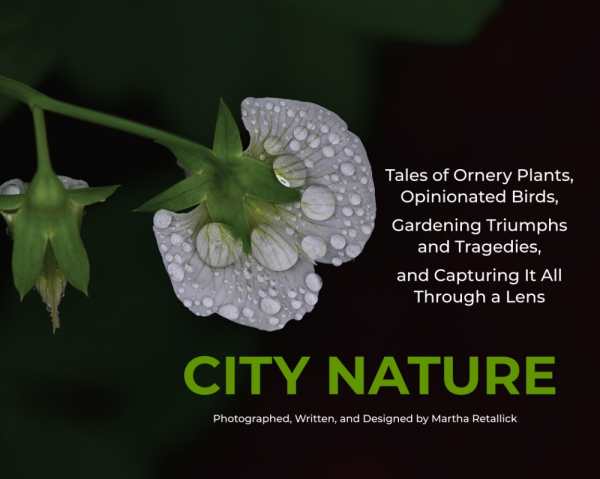City Nature
Tales of Ornery Plants, Opinionated Birds, Gardening Triumphs and Tragedies, and Capturing It All Through a Lens
City Nature is an earnest, delightful foray into the possibilities of urban agriculture.
Martha Retallick’s coffee table book City Nature showcases urban agriculture through a photographer’s passionate lens.
The Sonoran Desert is a challenging climate in which to grow a garden, but that’s exactly what photographer Martha Retallick set out to do. At the recommendation of a friend, she decided to undertake the decades-long work of transforming her little plot of land into an urban garden. And when COVID-19 decreased demand for event photographers, Retallick turned her camera to the flora and fauna that flourished in her own backyard. These resulting photographs and accompanying writings dispel the myth that the natural world and city life must be mutually exclusive.
The book’s genuine awe and respect for nature is conveyed through prose and photography. Retallick writes that “urban nature is powerful—it can push grass right through asphalt roads and force trees up through the sidewalks.” Many of her photographs echo this tension: a curved-bill thrasher sits on a rusted fence, an assortment of homegrown fruit gathers in a stainless-steel bowl, and potted plants and vegetables grow alongside her house. Other photographs (as of a shy pomegranate bud just beginning to eke open or the dewdrops on a snow pea flower) showcase the natural delights possible in an urban garden.
The book’s reach is wide. Alongside its esoteric step-by-step guide through the photographic process and specific references to certain cameras, lenses, and settings, there are instructions for crafting a gray water system, setting up a cistern, and protecting plants from pests like javelinas and rabbits. Between photographs, an abundance of gardening tips are introduced, too, as with notes regarding the importance of plant-friendly laundry detergent and on helping overwatered plants recover. Some of this work is specific to the Southwest, and some of the named resources are only available to Tucson-area residents. Recipes for salsa and gluten-free mesquite flour expand the book’s work further, though.
The prose is enthusiastic but concise. A story about removing a month’s worth of bird manure is summarized with “Yuck! And then the dirty job was done.” Still, there are compelling observational details and literary craftsmanship in some descriptions, as of how mourning doves feed their offspring:
The male and female adults both produce a liquid called crop milk. It consists of sloughed off, liquid-filled cells from an enlargement of the esophagus called the crop, and it’s rich in the things that squabs need, like antioxidants, fat, and protein. For the first few days of their lives, the squabs live on crop milk, which the parents regurgitate into their throats.
Part memoir, part coffee table book, City Nature is an earnest, delightful foray into the possibilities of urban agriculture, nature photography, and sustainable living.
Reviewed by
Hannah Pearson
Disclosure: This article is not an endorsement, but a review. The publisher of this book provided free copies of the book and paid a small fee to have their book reviewed by a professional reviewer. Foreword Reviews and Clarion Reviews make no guarantee that the publisher will receive a positive review. Foreword Magazine, Inc. is disclosing this in accordance with the Federal Trade Commission’s 16 CFR, Part 255.

